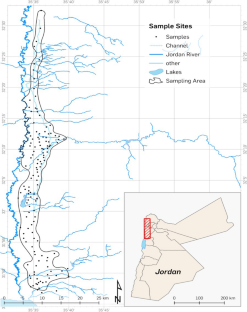Environmental Earth Sciences ( IF 2.8 ) Pub Date : 2024-04-04 , DOI: 10.1007/s12665-024-11537-x Mamoun A. Gharaibeh , Ammar A. Albalasmeh , Nicolai Moos , Osama Mohawesh , Chris Pratt , Ali El Hanandeh

|
In arid regions such as the Jordan valley, salinity and sodicity are major constraints to soil quality and crop production. Accurate spatial determination of sodicity and salinity at field scale is a challenge, which can limit the effectiveness of management strategies. Interpolation techniques are used to derive maps to estimate the extent of the areas affected by sodicity and devise appropriate management plans. Nevertheless, different methods may draw different pictures. The main objectives of this study are to compare two interpolation techniques: 1. empirical Bayesian (EBK) and 2. disjunctive kriging (DK) to spatially predict soil salinity and sodicity in intensively used agricultural soils. Surface and subsurface samples were collected from randomly selected agricultural fields and analyzed for salinity (ECe) and sodicity (sodium adsorption ratio -SARe and exchangeable sodium percentage -ESP). Both EBK and DK methods revealed serious soil salinization and sodification problems in the middle and southern parts of the Jordan Valley. Salinity (ECe) maps showed that about 34% of the total area has salinity < 4, 12% < 8, 7% < 16, and 46% exceeds 16 dS m−1. For sodicity (ESP), 44% < 10, 18% < 15, and 37% > 15. Surface soils had higher salinity and sodicity levels than subsurface soils. The average values of surface soils were ECe (15.7 dS m−1), SARe (9.8), and ESP (15.5), compared with ECe (7.4 dS m−1), SARe (7.5), and ESP (13.1) for subsurface soils. Smoother and less patchy predictions were generated using DK compared to EBK. However, EBK had higher accuracy than DK in spatially predicting and addressing the uncertainty inherent in soil salinity and sodicity. This investigation gives important fundamental steps for developing site-specific reclamation techniques to manage and sustain agriculture in these regions.
中文翻译:

使用经验贝叶斯和析取克里金法预测约旦河谷灌溉土壤盐度和碱度分布的比较分析
在约旦河谷等干旱地区,盐度和碱度是土壤质量和作物生产的主要制约因素。在田间准确确定碱度和盐度的空间是一项挑战,它可能会限制管理策略的有效性。插值技术用于绘制地图,以估计受碱度影响的区域范围并制定适当的管理计划。然而,不同的方法可能会画出不同的图画。本研究的主要目的是比较两种插值技术:1. 经验贝叶斯 (EBK) 和 2. 析取克里金法 (DK),用于空间预测密集使用的农业土壤中的土壤盐度和钠度。从随机选择的农田中采集地表和地下样品,并分析盐度 (ECe) 和钠度(钠吸附比 -SARe 和交换钠百分比 -ESP)。 EBK和DK方法都揭示了约旦河谷中部和南部地区严重的土壤盐碱化和固化问题。盐度(ECe)图显示,约34%的总面积盐度<4,12%<8,7%<16,46%超过16 dS m -1。对于钠度 (ESP),44% < 10、18% < 15 和 37% > 15。表层土壤的盐度和钠度水平高于地下土壤。表层土壤的平均值为ECe (15.7 dS m −1 )、SARe (9.8) 和ESP (15.5),而地下土壤的ECe (7.4 dS m −1 )、SARe (7.5) 和ESP (13.1)则不同。土壤。与 EBK 相比,使用 DK 生成的预测更平滑、更少不均匀。然而,在空间预测和解决土壤盐度和碱度固有的不确定性方面,EBK 比 DK 具有更高的准确性。这项调查为开发特定地点的开垦技术以管理和维持这些地区的农业提供了重要的基本步骤。



























 京公网安备 11010802027423号
京公网安备 11010802027423号